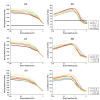Effect of Carbonyl Iron Particle Types on the Structure and Performance of Magnetorheological Elastomers: A Frequency and Strain Dependent Study
- PMID: 36236145
- PMCID: PMC9570794
- DOI: 10.3390/polym14194193
Effect of Carbonyl Iron Particle Types on the Structure and Performance of Magnetorheological Elastomers: A Frequency and Strain Dependent Study
Abstract
Magnetorheological elastomers (MREs) are smart viscoelastic materials in which their physical properties can be altered when subjected to a varying magnetic field strength. MREs consist of an elastomeric matrix mixed with magnetic particles, typically carbonyl iron particles (CIPs). The magnetic field-responsive property of MREs have led to their wide exposure in research. The potential development and commercialization of MRE-based devices requires extensive investigation to identify the essential factors that can affect their properties. For this reason, this research aims to investigate the impact of CIPs' type, concentration and coating on the rheological and mechanical properties of MREs. Isotropic MREs are fabricated with four different CIP compositions differing between hard or soft, and coated or uncoated samples. Each MRE composition have three different concentrations, which is 5%, 10%, and 20% by volume. The dynamic properties of the fabricated samples are tested by compression oscillations on a dynamic mechanical analyzer (DMA). Frequency and strain dependent measurements are performed to obtain the storage and loss modulus under different excitation frequencies and strain amplitudes. The emphasis is on the magnetorheological (MR) effect and the Payne effect which are an intrinsic characteristics of MREs. The effect of the CIPs' type, coating, and concentration on the MR and Payne effect of MREs are elucidated. Overall, it is observed that, the storage and loss modulus exhibit a strong dependence on both the frequency excitations and the strain amplitudes. Samples with hard and coated CIPs tend to have a higher MR effect than other samples. A decrease in the storage modulus and non-monotonous behavior of the loss modulus with increasing strain amplitude are observed, indicating the Payne effect. The results of this study can aid in the characterization of MREs and the proper selection of CIPs grades based on the application.
Keywords: MR effect; Payne effect; dynamic properties; frequency-dependence; magnetic particles; magnetorheological elastomers; strain-dependence.
Conflict of interest statement
The authors declare no conflict of interest.
Figures










Similar articles
-
Mechanical Properties Comparison of Isotropic vs. Anisotropic Hybrid Magnetorheological Elastomer-Fluid.Polymers (Basel). 2024 Apr 26;16(9):1215. doi: 10.3390/polym16091215. Polymers (Basel). 2024. PMID: 38732684 Free PMC article.
-
Experimental study of the magnetic field enhanced Payne effect in magnetorheological elastomers.Soft Matter. 2014 Nov 21;10(43):8765-76. doi: 10.1039/c4sm01738b. Soft Matter. 2014. PMID: 25278263
-
Material Characterization of Magnetorheological Elastomers with Corroded Carbonyl Iron Particles: Morphological Images and Field-dependent Viscoelastic Properties.Int J Mol Sci. 2019 Jul 5;20(13):3311. doi: 10.3390/ijms20133311. Int J Mol Sci. 2019. PMID: 31284462 Free PMC article.
-
Recent Progress in Isotropic Magnetorheological Elastomers and Their Properties: A Review.Polymers (Basel). 2020 Dec 17;12(12):3023. doi: 10.3390/polym12123023. Polymers (Basel). 2020. PMID: 33348727 Free PMC article. Review.
-
Magnetic Particle Filled Elastomeric Hybrid Composites and Their Magnetorheological Response.Materials (Basel). 2018 Jun 19;11(6):1040. doi: 10.3390/ma11061040. Materials (Basel). 2018. PMID: 29921808 Free PMC article. Review.
Cited by
-
Molecular dynamics and experimental analysis of energy behavior during stress relaxation in magnetorheological elastomers.Sci Rep. 2024 Aug 25;14(1):19724. doi: 10.1038/s41598-024-70459-7. Sci Rep. 2024. PMID: 39183301 Free PMC article.
-
Mechanical Properties Comparison of Isotropic vs. Anisotropic Hybrid Magnetorheological Elastomer-Fluid.Polymers (Basel). 2024 Apr 26;16(9):1215. doi: 10.3390/polym16091215. Polymers (Basel). 2024. PMID: 38732684 Free PMC article.
References
-
- An H.N., Picken S.J., Mendes E. Direct observation of particle rearrangement during cyclic stress hardening of magnetorheological gels. Soft Mater. 2012;8:11995–12001. doi: 10.1039/c2sm26587g. - DOI
-
- Schümann M., Odenbach S. In-situ observation of the particle microstructure of magnetorheological elastomers in presence of mechanical strain and magnetic fields. J. Magn. Magn. Mater. 2017;441:88–92. doi: 10.1016/j.jmmm.2017.05.024. - DOI
-
- Díez A.G., Tubio C.R., Etxebarria J.G., Lanceros-Mendez S. Magnetorheological Elastomer-Based Materials and Devices: State of the Art and Future Perspectives. Adv. Eng. Mater. 2021;23:2100240. doi: 10.1002/adem.202100240. - DOI
-
- Salem A.M.H., Ali A., Muthalif A.G.A., Ramli R.B., Julai S. Magnetorheological Elastomer Based Flexible Metamaterials Coupler for Broadband Longitudinal Vibration Isolation: Modeling and Experimental Verification. IEEE Access. 2021;9:165451–165461. doi: 10.1109/ACCESS.2021.3134267. - DOI
-
- Jang D.I., Yun G.E., Park J.E., Kim Y.K. Designing an attachable and power-efficient all-in-one module of a tunable vibration absorber based on magnetorheological elastomer. Smart Mater. Struct. 2018;27:085009. doi: 10.1088/1361-665X/aacdbd. - DOI
LinkOut - more resources
Full Text Sources

